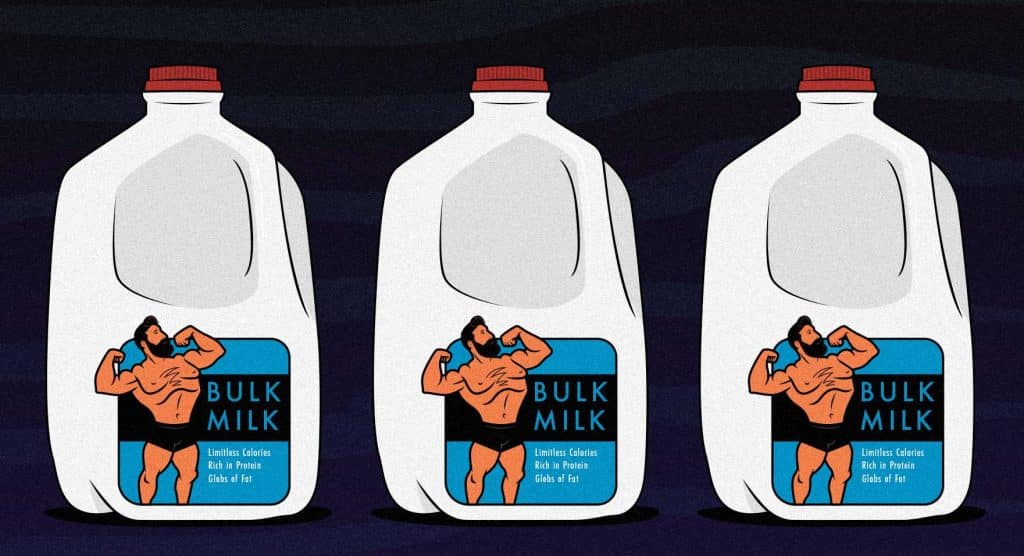
Is Milk Good for Bulking? (What About GOMAD?)
Milk is one of the easiest sources of calories and protein, making it great for bulking. Adding a glass or two of milk to your diet might be all it takes to slip into an easy calorie surplus. That’s especially handy for skinny people (like me) who have a hard time eating enough calories to gain weight.
Milk is also a rich source of micronutrients, including the obvious ones, like calcium. More interestingly, it seems to have other unique muscle-building properties. More on that in a second.
The problem is that if you drink too much milk, you may find yourself gaining quite a lot of fat (study). In fact, drinking a gallon of milk a day (GOMAD) is so infamous for making guys fat. It’s the classic “dreamer bulking” diet.
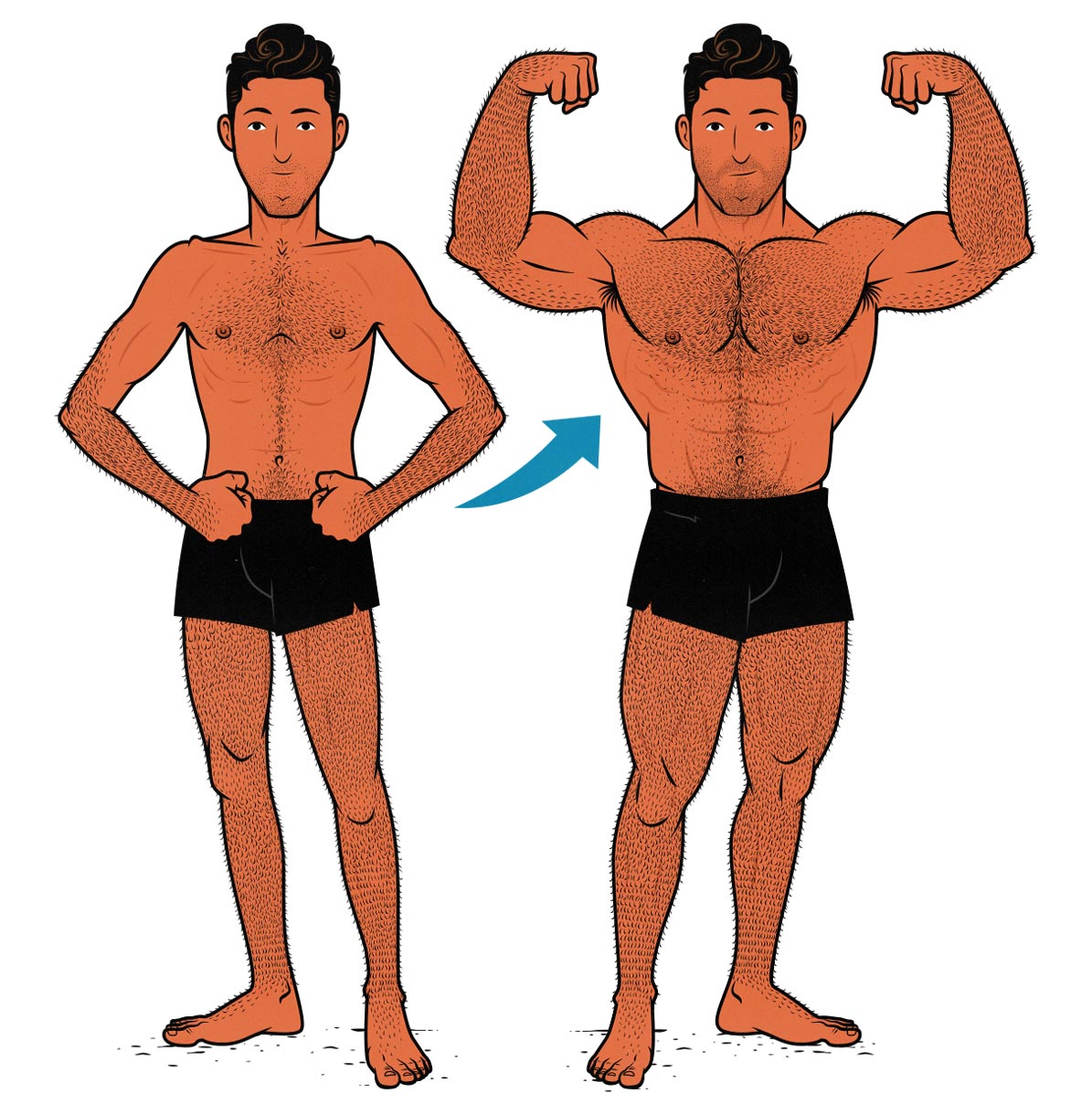
Is Milk Good for Building Muscle?
The short answer is yes. Milk can be great for helping guys build muscle. This is especially true for skinny guys who struggle to gain weight. That’s because milk is one of the easiest sources of calories, and a calorie surplus will make you gain weight (study, study, study).
The benefits of milk go beyond just protein and calories, though:
- Zinc, selenium, and magnesium: Bodybuilders and strength athletes often supplement with these three minerals in an attempt to boost their testosterone production. These minerals don’t actually boost testosterone production, but if you’re deficient in them, your testosterone production can be suppressed. Getting enough of these minerals helps keep your testosterone production in good working order, which can help you build more muscle more leanly. (Milk also contains vitamin A, vitamin b12, vitamin b6, niacin, thiamine, riboflavin, folate, and potassium.)
- Vitamin D: Milk is often fortified with vitamin D. Again, a deficiency in vitamin D can suppress testosterone production, so milk could potentially help. Mind you, a better way to get vitamin D is to spend more time in the sun, and the quantities of vitamin D in milk are quite low anyway. Still, it can help.
- Amino acids: The protein in milk has a favourable breakdown of amino acids for building muscle. Among these amino acids is leucine, which is known for stimulating muscle protein synthesis. In fact, along with whey protein, milk is arguably the best source of protein for building muscle.
- Calcium / bone health: Robert Heaney, MD, conducted a systematic review on the effects of milk on bone health, concluding that milk was great for building stronger bones.
- Casein protein: Around 80% of the protein in milk comes from casein, which digests slowly and steadily. Theoretically, that means that if you have milk in the evening, the casein would gradually digest over the course of the night, allowing you to build more muscle while you sleep. (Meat also digests quite slowly, yielding the same effect.)
- Casomorphins: This is a weird one. Our bodies break down casein into casomorphins, which have about 1/10th the painkilling effect of morphine.
Because of how easily milk can turn a regular diet into a bulking diet, it has a long history of helping guys build muscle. For example, check out 50s strongman Paul Anderson:
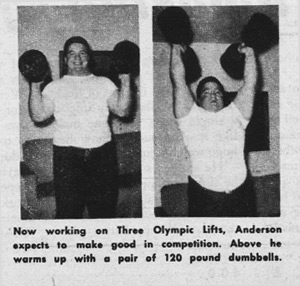
Paul Anderson’s story is both an inspiring and scary example of milk’s ability to transform men into Beasts. On one hand, he became the strongest man in the world through smart training and consuming monstrous quantities of milk. On the other hand, he also became morbidly obese and died in his 60s.
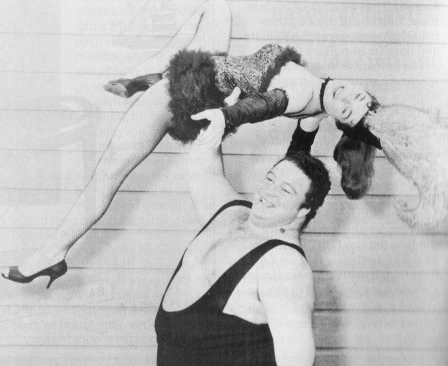
So, although milk is famous for helping guys build muscle, many guys are also nervous about drinking it.
Is It Healthy to Bulk on Milk?
When it comes to body composition, a recent study found that people who drink milk tend to have more muscle, less fat, and greater bone density. So, milk is definitely healthy in the sense that it can help us become leaner and stronger.
Mind you, body composition is just one aspect of health. The other concern is that milk could affect your hormones, especially if you’re drinking enough of it to bulk up. The research is still young, but here’s a quick rundown:
- The bovine growth hormone in milk has no known biological activity in humans.
- The estrogen in milk doesn’t seem to increase estrogen levels in the people who drink it, at least in adults (study).
- The insulin-like growth factor 1 (IGF-1) in milk is interesting. Milk does cause us to produce more IGF-1, but that’s often considered good by the people drinking it to bulk up. If there’s an effect, it would probably help you build more muscle. The IGF-1 is also potentially why teenagers who drink milk tend to grow taller (study). You can also get that benefit from other sources of protein. And, oddly enough, soy milk causes our IGF-1 levels to rise even higher than cow’s milk (study).
Is GOMAD Good for Bulking?
GOMAD was invented a hundred years ago by a weightlifting coach named Mark Berry. He believed the best way to bulk was to do high-rep squat-focused workouts while drinking an extra gallon of milk a day (alongside your regular meals). It was never supposed to be a way to gain weight leanly. In fact, Berry was more interested in “huskiness.” The idea was to get big, strong, and also kind of chubby.
GOMAD is still pretty popular. Nowadays, it’s usually used to help young athletes, such as high school football players, bulk up in a hurry. The protocol is usually something like this:
- Follow a squat-based training program, such as Starting Strength
- Drink a gallon of whole milk every day
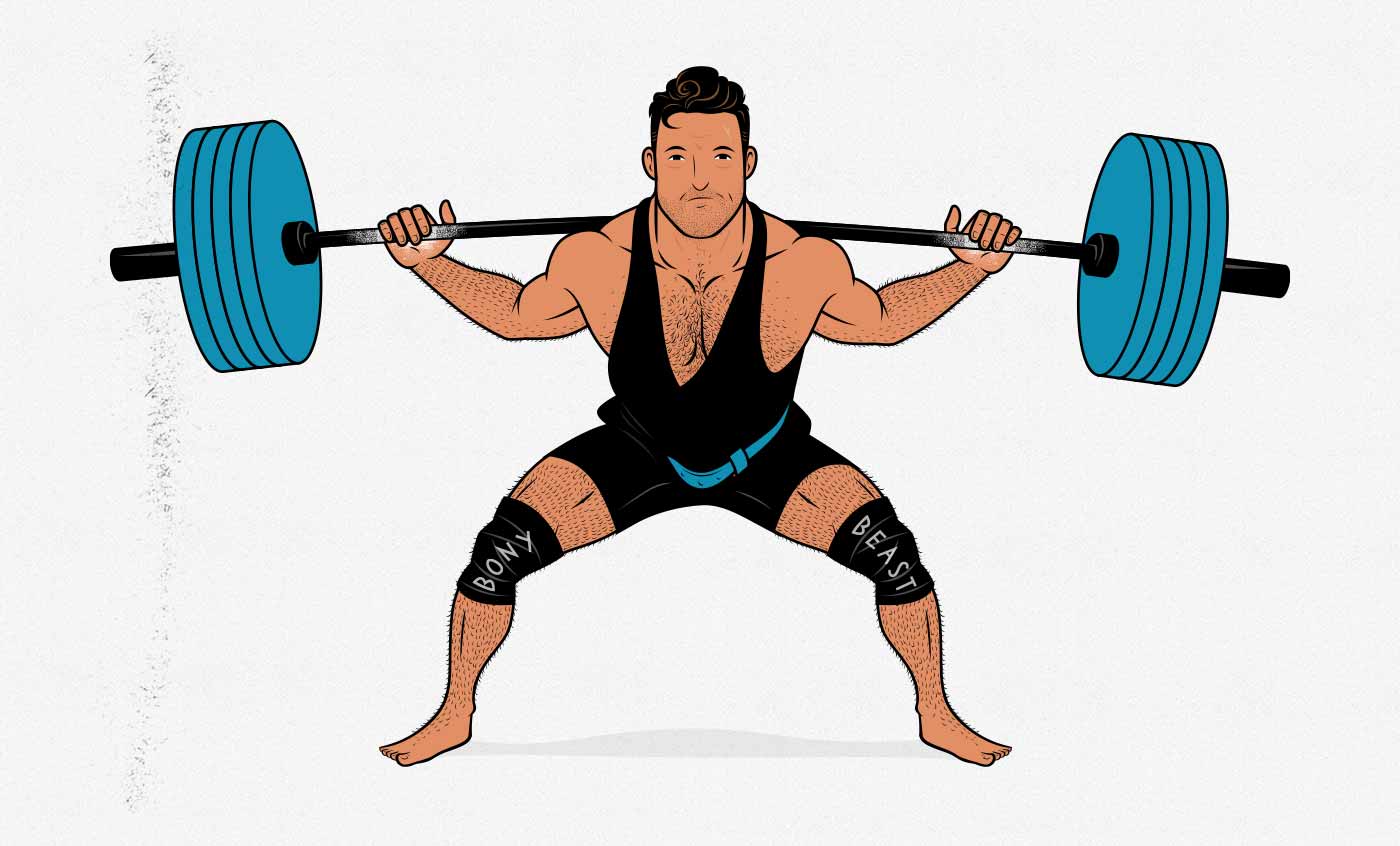
The first problem is that strength training isn’t very good for gaining muscle. It’s great for building bigger quads and glutes. And those are the biggest muscles in your body, so it’s not bad for gaining overall muscle mass. But it’s not very good for gaining muscle everywhere else, especially in your upper body.
The second problem is the saturated fat. A gallon of whole milk has around 75 grams of saturated fat. That’s three times the recommended amount of saturated fat while bulking (more on that here). And milk probably isn’t the best place to be getting your saturated fat anyway.
The third problem is that you’ll probably get quite fat. However, to be fair to GOMAD, the idea is to get big and bulky, not to build muscle leanly. Linemen don’t need to be lean; they just need to be big and strong. So let’s ignore that part. Instead, let’s focus on the gallon of whole milk.
The macros of a gallon of whole milk are:
- 2,300–2,500 calories
- 125 grams of fat
- 185 grams of carbohydrates
- 120 grams of protein
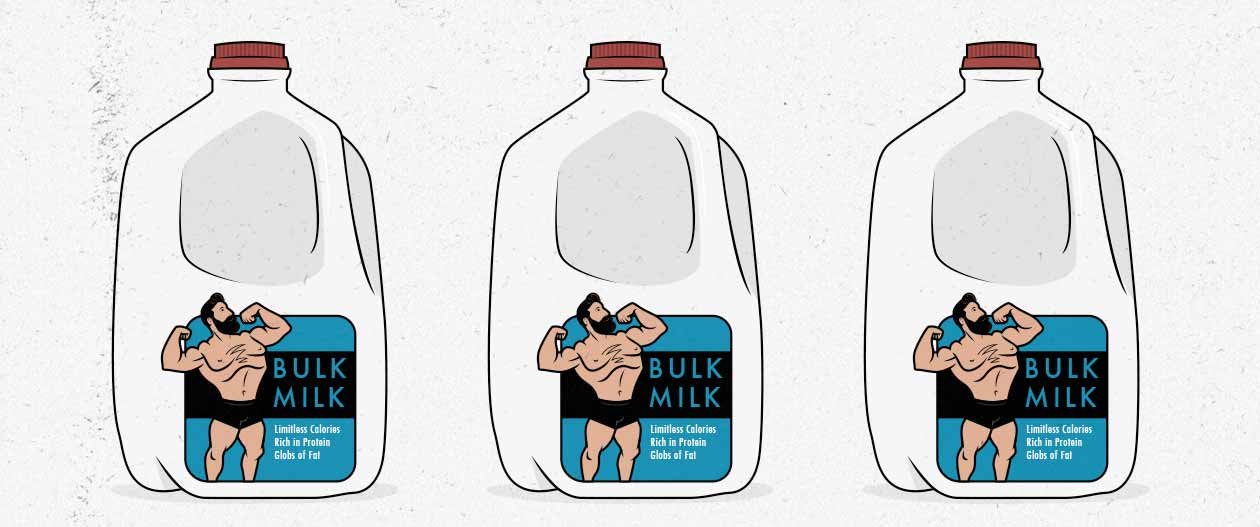
This gallon of whole milk is going to be fairly easy to drink because it’s liquid, it’s low in fibre, and it will pass through your digestive system fairly quickly. Even though it’s an absurd amount of milk, it’s actually not that hard to stack on top of your regular diet.
The problem is, stacking 2,400 calories on top of your regular diet is going to cause a ton of weight gain, most of which will be fat. That’s almost 5x the recommended calorie surplus, even for a skinny beginner who’s lifting weights.
However, if we put this in the context of a college football player, this starts to make more sense. If someone spends most of their time exercising, they’ll need a ton of calories. And if the goal is simply to gain a bunch of weight, then it makes sense to eat in a huge calorie surplus. That’s how you build a massive lineman with a ton of momentum to throw around.
Plus, college football players are incredible active, which can at least partially offset the higher intake of saturated fat. The more active you are, the more visceral fat you’ll burn. That doesn’t mean it’s healthy to eat that much saturated fat, and I still don’t recommend it, but at least it’s less bad.
Is LOMAD Good for Bulking?
LOMAD is a litre of whole milk a day. It’s the more moderate version of GOMAD. It’s also the version with which I have the most experience. It’s amazing for building.
The macros of a litre of whole milk are:
- 630 calories
- 34 grams of fat
- 49 grams of carbohydrates
- 32 grams of protein
We normally recommend that skinny beginners start their bulk by adding about 500 calories to their daily calorie intake. This is just a little bit higher than that. That’s fine. People normally need to raise their calories as they progress through a bulk anyway, so this simply starts the calories off a little higher. That’s perfect fine.
Then, if we’re talking about low-fat milk, the macros get even better:
- 440 calories
- 10 grams of fat
- 52 grams of carbohydrates
- 32 grams of protein
That adds 440 calories to your diet, with most of those calories coming from carbs and protein. This will give you a good shot at building muscle quickly and leanly, especially if you combine it with a workout program designed to help you gain muscle size.
My Experience Bulking With LOMAD
When I was underweight (6’2 and 130 pounds), I was working at an ad agency on the illustration team. I was new there, and also newly determined to gain 20 pounds. I had read about GOMAD, where you drink a gallon of milk every day. I loved the idea, but I wanted to ease into it. I decided to start with LOMAD instead, drinking a litre of milk every day.
To do this, I brought a 1-litre bag of milk to work with me and gradually worked my way through it over the course of the day. At lunch, I’d walk over to Subway and grab myself a 6-inch meatball sub with extra cheese. In the afternoon, I’d snack on a protein bar or some trail mix.
That was my first experience with LOMAD. Or at least I thought it was. A couple of months after I started my bulk, one of my coworkers started complaining to everyone that by the end of the day, every single day, I would always finish the milk, leaving none for her after-work coffee. She was appalled that I was so consistently inconsiderate.
She complained to the boss, and I got called in. I had to explain that I was bringing my own personal milk to the office. I wasn’t hogging the office’s milk. Rather, she’d been using my milk for her coffees. My boss thought it was quite funny, and when I turned 22 a couple of months later, he made an illustration of it for my birthday card.
Anyway, that milk helped me gain 20 pounds in 4 months. It was my third or fourth attempt at bulking, and it was the first time I ever succeeded:
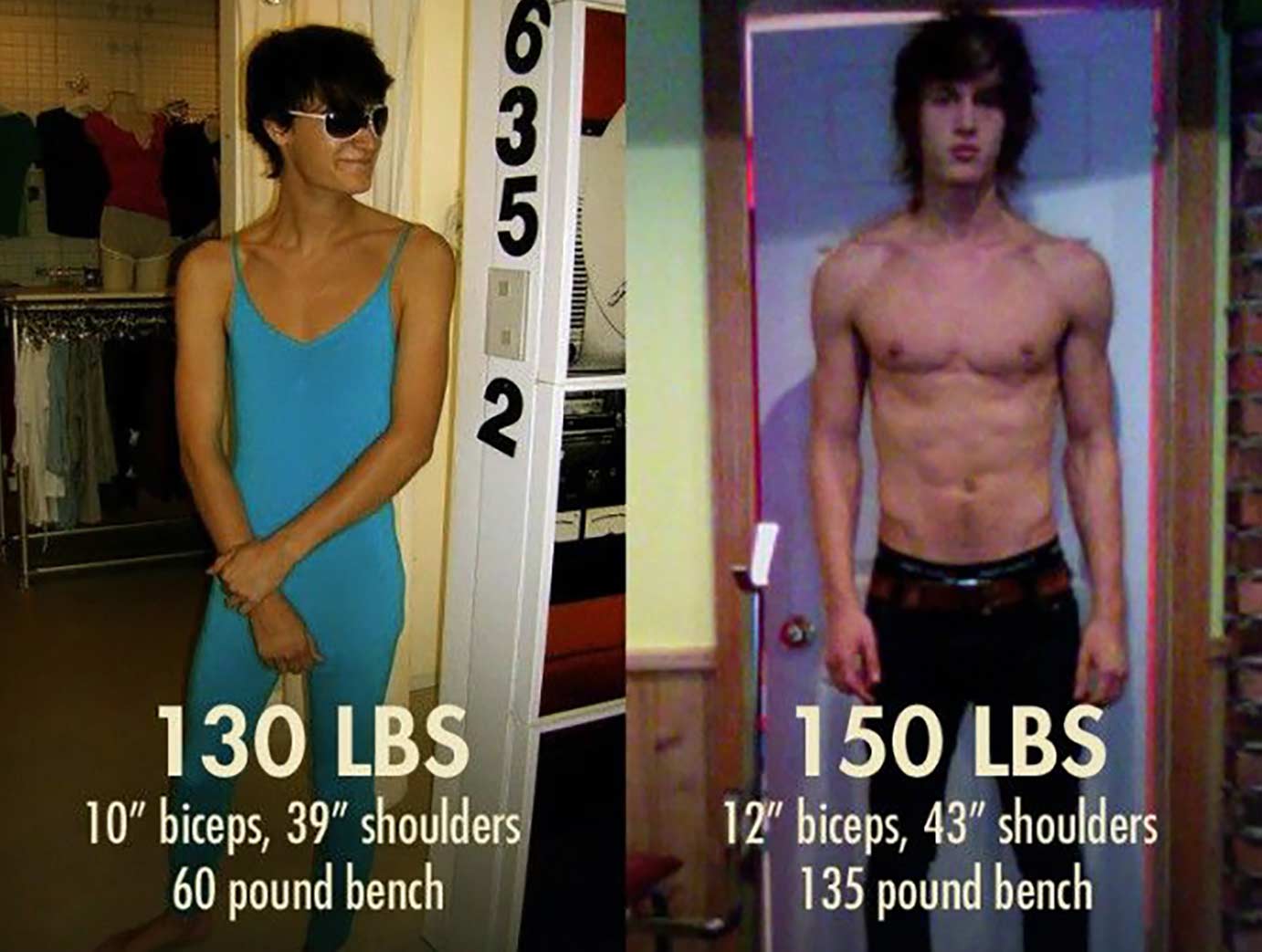
I’ve been using milk to help me bulk up since then, too, gaining a total of 70 pounds (at the same body fat percentage as when I started). You can read more about that transformation here.
Milk and Digestion
Most people digest milk quite quickly and easily. That’s a huge part of why it’s so popular for bulking. It allows us to consume more calories and protein without putting much strain on our digestive systems.
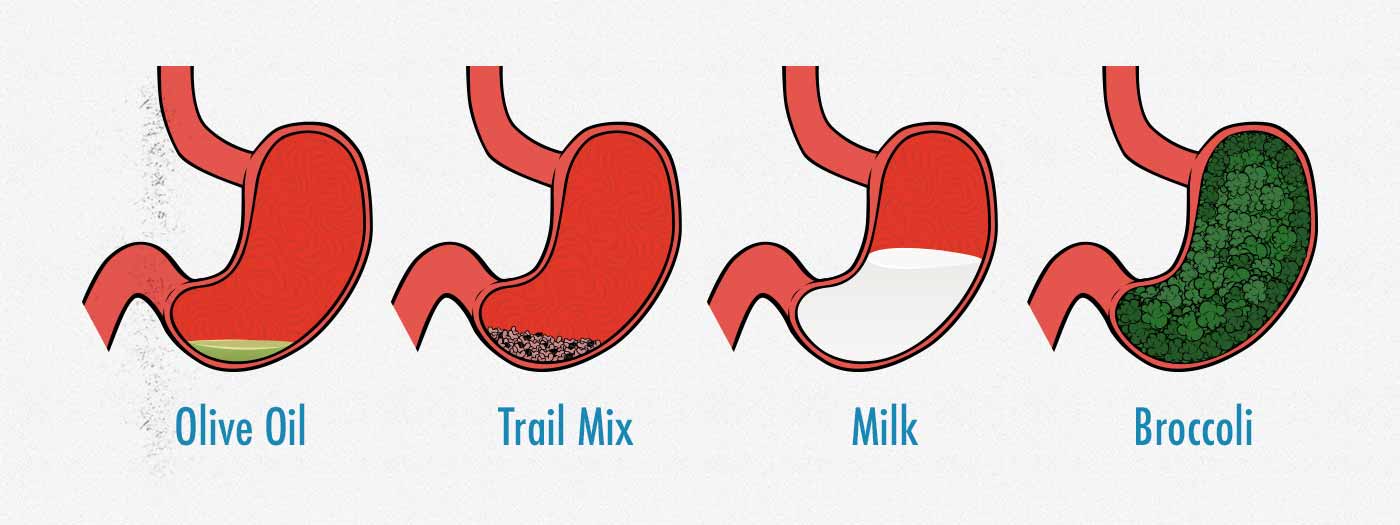
It’s not that it takes up less space in our stomachs. Milk is less calorically dense than foods like olive oil and trail mix. But because it’s a liquid, it passes through quite quickly, allowing us to eat again shortly afterwards.
However, milk contains a sugar called lactose. To digest that lactose, we use the digestive enzyme lactase, which some people have more of than others. If you don’t have enough lactase to digest all the lactose you’re consuming, you’ll start to feel bloated and nauseous.
Earlier studies have suggested that certain cultures are better at digesting milk than others. People of Northern European descent tend to digest it well, whereas many people of Asian and African descent struggle with it (study). At first, researchers thought this was due to genetics. Now, they think it’s due to upbringing (study). Most research shows that if you gradually introduce milk into your diet, you’ll probably begin producing the digestive enzymes you need.
If you’re having trouble digesting milk, that’s where lactose-free milk comes in. Lactose-free milk isn’t actually free of lactose; it just comes with the digestive enzyme lactase already mixed in.
Lactose-free milk doesn’t help everyone, though. Some people are allergic to milk, which is an entirely different problem. In that case, you shouldn’t have milk at all. The last thing you want to do while bulking is introduce something into your diet that messes with your digestive system.
Is Whole-Fat or Low-Fat Milk Better for Bulking?
There’s some evidence suggesting whole milk is better than low-fat milk for building muscle (study). One of the reasons milk is good for building muscle is that it’s rich in protein, right? So, you’d think that if you swapped whole milk for skim milk, giving you nearly twice as much protein per calorie, you’d build more muscle. But that wasn’t the case. The participants who drank whole milk while bulking gained more muscle despite getting less protein.
There’s no conclusive answer on why whole milk is better for building muscle, if that’s even the case at all. It might be that the processing of whole milk is less extreme. Maybe it’s because some of the vitamins and minerals in milk are fat-soluble, meaning that whole milk contains more micronutrients.
The downside to bulking with whole milk is that it’s high in saturated fat. The fat in cheese, yogurt, and kefir doesn’t usually pose any problems (more on that here), but there’s some evidence suggesting that whole milk is associated with higher rates of heart disease (meta). The evidence is mixed, but if you’re drinking large amounts of milk while bulking to bring yourself into a calorie surplus, that’s exactly the sort of situation where you’d expect it to be a problem.
Fortunately, low-fat milk, cheese, yogurt, and kefir were all perfectly fine. So, what I do is get some dairy fat from cheese, yogurt, and kefir, and then I drink low-fat milk.
Does Bulking With Milk Cause Fat Gain?
People get fat from drinking too much milk because they’re consuming too many calories, and those extra calories spill over into fat storage. If someone is doing GOMAD, where they drink a gallon of whole milk every day, then they’re getting upwards of 2,500 calories per day just from milk alone.
The problem isn’t with milk, though. It’s just that you shouldn’t drink too much of it or bulk too aggressively.
How to Bulk With Milk
First, make sure your bulking plan is good overall:
- Follow a good workout program: The more muscle growth your workouts can stimulate, the more lean weight you’ll be able to gain, and the less likely you’ll be to store fat. Here’s our article about the best kind of lifting for building muscle.
- Eat enough protein: 1 gram of protein per pound of body weight per day is enough to fully maximize your rate of muscle growth (article). Milk is perfect for this. If you’re falling short, low-fat milk has more protein per calorie. Ultra-filtered milk (like Fairlife) has even more.
- Gain weight at a slow and steady pace: Most people do best when they gain 0.25–0.5 pounds per week, but if you’re skinny or a beginner, then you might want to bump that up to 0.5–1 pound per week, at least during your first few months of bulking. If you want to use milk for that, have a glass of milk alongside your main meals. If you’re using whole milk, have a small glass. If you’re using low-fat milk, have a big glass.
- Eat mostly whole foods: your diet doesn’t need to be perfect, but I recommend getting around at least 80% of your calories from whole foods. Milk counts as a whole food, and there are plenty of other great bulking foods.
Here are a few ways to work milk into a good bulking diet:
- LOMAD: Gradually work your way through a litre of milk every day. You could have a pint of milk as a snack, or you could have a glass of milk alongside your meals. If your diet is mostly plant-based, whole milk might work better for you. If you already eat a lot of meat or fat, maybe choose low-fat milk.
- Milk for Protein: Whenever you have a meal that’s low in protein (or low in calories), add a glass of milk. For example, if you have a peanut butter and banana sandwich for lunch, add a glass of milk. If you have a bowl of pasta for dinner, add a glass of milk. By adding the milk to your meals, you’re boosting their protein content. If this helps you get to 20 grams of protein in each meal, or if it helps you hit your daily protein target, then it will help you build muscle more quickly and leanly.
- Milk as a Snack: If you need a bulking meal on the run, dip into a corner store and buy a quart/litre of milk. If you combine that with almost anything else (e.g. trail mix), you’ll have a perfect on-the-go bulking meal.
Whichever approach you use, remember to ease into it. Start with a single extra cup of milk per day. If that goes well, add another cup. I don’t see any problem with drinking a litre of milk per day (LOMAD). That’s still a fairly moderate intake. However, as you push deeper, drinking closer to a gallon of milk per day (GOMAD), it becomes harder to say whether that could negatively impact your health.
If you’re still having trouble gaining weight after adding a litre of milk to your diet, here’s our guide on how to eat more calories. It might make more sense to start adding calories from other bulking foods, such as trail mix. That will give you a more balanced bulking diet.
Here’s how to adjust your milk intake based on your results:
- If you’re not gaining weight quickly enough, add an extra glass of milk.
- If you’re gaining weight too quickly, cut back on the calories (from any source).
- If you’re gaining weight at a good pace but you’re gaining too much fat, then you could slow your bulk down, but you may have a deeper problem. You might need to improve your workout program, your overall diet, or your lifestyle.
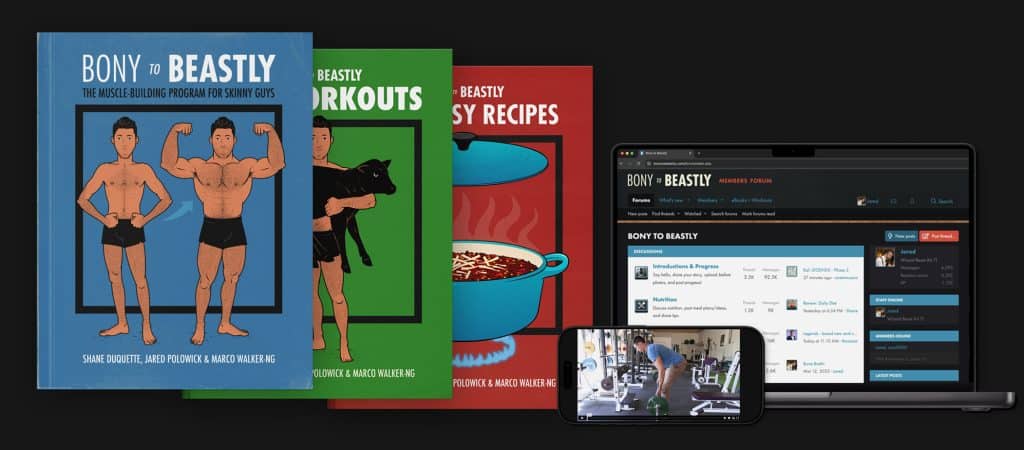
If you want our help, we include a full nutrition guide and recipe book in our Bony to Beastly Bulking Program and Legends: Health & Aesthetics Program. We take this stuff seriously. We’ll teach you how to eat a bulking diet that’s healthy and balanced, and that’s perfect for building muscle leanly. We include a full recipe book, too, with all the macros calculated out and all the micronutrients balanced.
Both of those programs include a full 5-month workout program, tutorial videos teaching every exercise, a full bulking guide going deep into every detail, and online coaching and support from us.

